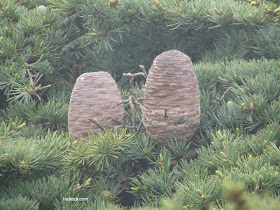



The cedar, Lebanon’s national emblem, is an important asset in the country’s national heritage. At first sight it may seem strange that something belonging to the vegetable kingdom should be part of the cultural patrimony. But, as M. Joseph Chami rightly says in an interesting study which inspired this article, the cedar can be classified as an archaeological monument. The 400 cedars of Becharreh are just as valuable historical remains as the ruins of Byblos, Baalbek or Tyre. What is more, they are still-living witnesses of the time when Hiram-Abi of Tyre built the temple of Solomon in Jerusalem.


In his book on Carthage and its Phoenician antecedents, Pierre Hubac writes: “The cedar is precious, more than precious, it is sacred. In Egypt, the cedar is the Zed tree, the tree that is a god, it is Osiris. It is also incorruptible material that bestows immortality. It is the wood for religious objects. Later, the cedar was to remain the religious wood par excellence: the cedar is the Church. For Islam, the cedar is the sacred wood, the pure wood...”
In nearly all religions and in most literature the cedar - not just any cedar - but the Cedar of Lebanon, has a place apart. It is an object of veneration. It is also a subject of meditation, comparison, exaltation.




All Eastern travelers speak of it, but Lamartine gives the most beautiful description of it: “The Cedars of Lebanon, he says, are the most famous natural monuments in Universe. Religion, poetry and history have all celebrated them because of the reputation for magnificence and holiness that these prodigies of vegetation have enjoyed since the earliest antiquity...These ancient witnesses of past ages know history better than does history itself...”. The Cedar of Lebanon is mentioned in the works of Ovid, in Pliny the Elder’s Natural History, in Horace and Persius. There are references to it in Egyptian inscriptions, on Babylonian and Assyrian Steles, in the Universal History of Diodorus Siculus, on the monuments of Greece and Rome and, of course, in Phoenician inscriptions.






It is mentioned in 70 different passages in the Bible. The Prophet Ezekiel gives a moving description of the “Tree of God”: “...a Cedar of Lebanon with fair branches and a shadowing shroud, and of a high stature, and his top was among the thick boughs. The waters made him great, the deep set him up on high with her rivers running about his plants... Therefore his height was exalted above all the trees of the field... All the fowls of heaven made their nests in his boughs, and under his branches did all the beasts of the field bring forth their young, and under his shadow dwelt all great nations...nor any tree in the garden of God was like unto him in his beauty. I have made him fair by the multitude of his branches, so that all the trees of Eden, that were in the garden of God, envied him.”





The book of Kings describes the building of the temple of Solomon in Jerusalem by engineers and workmen sent by Hiram the King of Tyre. There was a lavish use of cedar wood: “And he built the walls of the house within with boards of cedar, both the floor of the house and the walls of the ceiling. And he built twenty cubits on the sides of the house both the floor and the walls with boards of cedar, he even built them for it within, even for the most holy place... And the cedar of the house within was carved with knobs and open flowers: all was cedar, there was no stone seen.”.



Isaiah uses the cedar to point a moral when he says that: “ it is the Lord that deals severely with all pride and arrogance, with all greatness, with all the cedars of Lebanon, high and lofty”.
The Psalms tell us that “the righteous shall grow like a cedar in Lebanon”.



The most beautiful of all love songs, the Song of Solomon, describes the beloved as follows: “His countenance is a Lebanon, excellent as the cedars”.
Such is the place occupied by the Cedar of Lebanon in the religious and literary monuments of humanity, a place so important that we can without any exaggeration regard the cedar as a cultural asset.
No comments:
Post a Comment